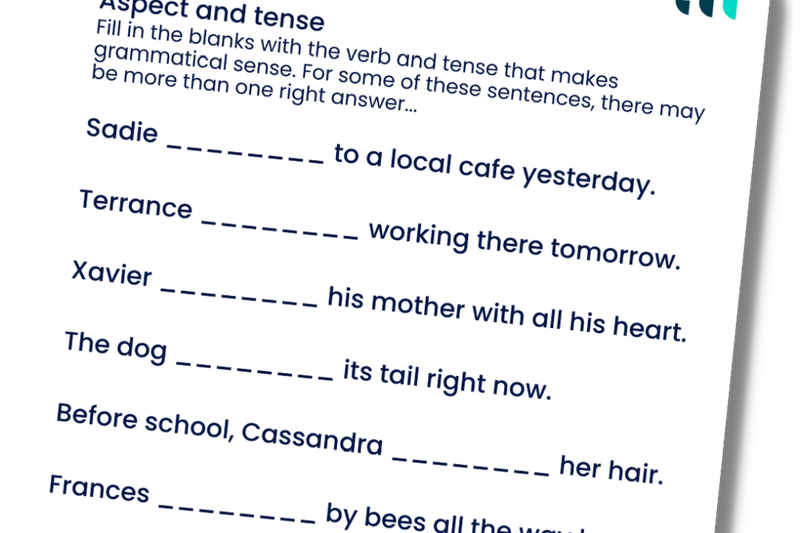Teaching grammar basics
Before we delve into tense and aspect, here are some of the other grammar guides available in our series on teaching grammar basics:
What is a verb?
A verb is one of the basic features of English grammar... but what is it?
A common answer you might receive to this question is, “It’s a doing word!” Whilst correct, that definition doesn’t provide a full picture of what a verb is and its function in language. What about verbs that describe mental states, such as ‘to believe,’ or verbs that denote states of possession, such as ‘to own’? Are these verbs considered doing words? What about time and duration, how do verbs express these features? The examples go on and on - verbs go far beyond the limited definition of “doing words”.
Peter Fenn, author of A Student's Advanced Grammar of English, claims that the distinctive feature of the verb is that, unlike nouns, it does not just name the event, but it also includes features of form that express an action or state dynamically as it unfolds in time. With that description in mind, let’s delve deeper into what verbs are and explore their two key features – tense and aspect.
What is tense?
Verbs are conjugated through their tense - in other words, the time they refer to. At its root, the English language has 3 tenses - past, present and future - that are used to express time when referring to a verb. Almost every time we speak, write or communicate, we use tenses to give further clarification.
However, despite being such a major presence in the English language, many native English speakers know close to nothing about tenses. The verbs we use in day to day life we conjugate without thinking - this is why many learners who speak English as an additional language may already know more about tenses than the average learner, as they are important to learning English.
This presents a unique problem when teaching learners grammar - some teachers, being native speakers of English, might not even think about tenses when conjugating verbs and thus may struggle to explain them. In order for every learner in the class to have equal opportunity, tenses should be taught explicitly - this blog explains tense and aspect, providing helpful strategies for teaching it as part of your grammar curriculum.
What is aspect?
Many grammar scholars claim that there are 12 tenses in English; however, this claim needs further clarification. Can there really be 12 different ways of expressing time in the English language? Let’s take a look at the following sentences:
- I walked to work yesterday.
- I was walking to work yesterday.
What is the difference between these sentences? It isn’t the time they refer to, because they are both in the past. The difference is their aspect – how an act or event is viewed in terms of its duration and completion. Sentence one has simple aspect, while sentence two has progressive aspect.
There are four aspects in English; when combined with our three methods of conveying the time, we are left with 12 tenses. Let’s take a deeper look at the four aspects of the English language.
Simple aspect
Simple aspect accounts for the following three tenses in English: the present simple, past simple, and future simple. It’s used for actions or events that occur at a certain time. The time is usually made clear by an adverb, such as ‘yesterday’ in sentence one above.
- “I watched a movie yesterday.”
Perfect aspect
Perfect aspect views an action or event from beginning to end and marks its completion; this tense is retrospective. The present perfect, past perfect, and future perfect tense all have this aspect. The verb in the following example is in the present perfect, ‘I have been to London.’ In this sentence, we see that the auxiliary verb ‘have’ is in its present tense form and is immediately followed by the past participle of go, ‘been.’
What is interesting is that in English both the past simple and the present perfect can be used to express the idea of completion or achievement; take for example the following two sentences:
- I bought my house.
- I have bought my house.
The past simple and present perfect only show that an action was completed, or a goal achieved when used with dynamic verbs, such as buy, write, or sing. This is because these verbs have an inherent end point. When non-dynamic verbs, or state verbs, are used in the past simple or present perfect, then they do not imply completion. This can be seen in the example, “I have been ill.” It’s unclear in this sentence whether the speaker has recovered or is still ill.
A challenging part of English grammar for learners is grasping the difference between uses of the past simple and the present perfect because, as we’ve seen, both are used to mark completion. The key difference between the two, outlined by Michael Lewis, is that the present perfect is a present tense form, and therefore it is always grounded at the point of now (the time of speaking). That’s why it’s typically used with adverbial phrases meaning at some or any time up until now, for example, ‘He has lived in London since 2018.’ A key feature of the present perfect is that it is ‘speaker-time oriented,’ not ‘action-time oriented,’ (which is the case for the past simple).
To make this distinction clearer, let’s take two people who are discussing a book that they’ve read. One might say to the other, “I have read that book twice.” Here, the choice of the present perfect emphasises the speaker’s perspective rather than the action itself; it shows that their reading of the book is connected to the current conversation. In contrast, if the speaker says, “I read the book twice,” then the emphasis is instead on the past action. In this case, the speaker doesn’t make a connection between the action and the time of utterance.

Progressive aspect
Progressive aspect, also referred to as the continuous, marks an event or action as ongoing and incomplete. The ongoing meaning of the progressive implies a reference point inside an action. This reference may be a point of time that is stated adverbially, such as, “By 8am, she was working in the office,” or it may be implied by another action which interrupts the ongoing one, for example, “She was working in the office when the fire alarm rang.”
To form a sentence in the progressive in English, we need a form of the verb ‘be’ and a main verb to which we add an -ing ending - for example, “She was working.” The progressive aspect gives us another three tenses in English: the present progressive, past progressive, and future progressive.
Interestingly, English is one of only a few languages that expresses the progressive aspect grammatically, giving it an -ing ending. Other languages, such as German, express the progressive aspect lexically. Therefore, speakers in German use the present simple with adverbs such as ‘now’ and ‘at the moment’ to express ongoing actions.
Perfect progressive aspect
The final aspect is the perfect progressive which provides us with the final three tenses: past perfect progressive, present perfect progressive, and future perfect progressive. These are the tenses that learners typically find the most challenging to use in their writing.
An example of the present progressive in a sentence is, ‘I have been living in London since 2014.’ This sentence conveys the idea that the speaker started the act of living in London in the past, and it is still ongoing.
Now we have a clear understanding of what tense and aspect are, let’s take a look at some of the difficulties learners may experience when encountering this grammar skill for the first time - to learn more about possible mistakes learners make when encountering grammar, read our full blog here.
3 common mistakes when learning tense and aspect
Issue One: Learners use state verbs with progressive aspect
Earlier, we discussed briefly that not all verbs represent actions in English and that some verbs denote states. While dynamic verbs relate to a point in time, such as, “He kicked the ball,’ state verbs describe a continuing situation extending through time, which means that the concept of duration is inherent to the verb’s meaning. Therefore, state verbs are not typically used in the progressive. This is why we say in English “I love you,” rather than “I’m loving you,” or “I own a car” rather than “I’m owning a car.”
There are a few instances when ‘I’m loving you’ might be possible, so rather than having fixed ideas about what is grammatical and ungrammatical in English, it’s useful to pay attention to context and be open to having discussions about exceptions and untypical usage with learners.
Issue Two: Learners use incorrect irregular forms
Learners may make errors when forming perfect tenses because they do not use the correct past participle. It’s not only children with English as an Additional Language (EAL) who are likely to make such errors in their writing - so are children who speak non-standard dialects of English. For example, in spoken English, many speakers say, ‘I’ve took the keys,’ rather than the standard, ‘I’ve taken the keys.’
It’s also important to acknowledge that while some regional dialects do break these rules of grammar, that doesn’t necessarily make them “wrong” - it is about understanding the correct grammar and recognising times when it is necessary, such as academic writing, and when it is not, like when having a conversation with friends. Conversations about irregular grammar in dialects can be an opportunity for a fruitful discussion.
Issue Three: Learners use the present perfect incorrectly
It can be challenging for learners from certain language backgrounds to make a distinction between action time, which is the marker of the past simple, and speaker time, the marker of the present perfect.
For example, if we take German, the perfect in this language has a construction very similar to English; however, it does not carry the same meaning as English. In German, the perfect can be used with adverbs of past time, such as ‘yesterday’ and ‘last week.’ Therefore, there is a tendency for speakers with German as a first language to produce incorrect sentences in English, such as, “I have been to the city yesterday.”
It is important for teachers to remember that every learner’s language background influences the way they understand grammar in English, so each learner may make different mistakes.

Five engaging ways to teach tense and aspect
Let’s take a look at some of the classroom activities you can use to help make learners more aware of tense and aspect in English and improve their writing skills.
1. Analyse authentic texts
Whilst reading texts in the classroom, it can be useful for learners to discuss various choices writers have made regarding tense and aspect and provide accounts for these choices. You could ask learners whether there are any different, yet possible, alternatives, and how these alternatives would alter meaning or shift emphasis.
As many learners use tense inconsistently throughout their writing, actively drawing attention to form can encourage them to be more mindful of and reflective about grammatical choices they make. It can also support them in becoming more effective readers by encouraging them to notice the order a series of events takes place in a text.
For some learners, it can be a challenge to grasp the idea that time is not expressed in a linear way in writing. Drawing attention to this will help learners understand, for example, that the past perfect is used to express a more remote action than the past simple.
2. Noticing activities
It’s helpful to draw learners’ attention to adverbials which are words or phrases that express time, such as “tomorrow” and “one week later.” This can lead to a class discussion about the tenses learners associate with certain adverbials. This activity may also highlight untypical use of tense in a text and promote further text analysis.
3. Gap-fill activities
It’s quick and easy to put together a gap-fill activity in which learners need to choose the correct tense to complete a sentence or select a tense they think would fit. You could use an excerpt from a novel or an interesting and current news article. You may even ask older learners to find their own texts and make their own worksheets which they then give to other students to complete in class and mark them afterwards.
4. Ordering activity
Another engaging activity is to print a paragraph in which a series of events happens and then cut it into separate clauses or sentences. You can then ask learners to fit the text back together again and write down in a column the linear order in which the events happen. In another column, ask learners to write when the events actually happened in chronological order. This will draw their attention to the role of tense and aspect and how they situate actions at different points in time.
5. Identify mistakes
You could put together a worksheet with a few sentences that include anonymous errors learners in your class have made in their writing or errors that someone learning English may make; lots of these can be found in George Yule’s book, Explaining English Grammar. The learners’ task is to go through the sentences and identify mistakes, correct them, and provide explanations that account for the correct form.
This is a fun activity for learners to do in small groups; they can discuss their ideas and discover together that oftentimes there is more than one answer, and this will naturally lead to a conversation about the effect that a writer’s choice has on meaning.
How Bedrock teaches tense and aspect
Bedrock Learning’s core curriculum features a rich grammar curriculum, teaching learners about English grammar skills through original fiction and nonfiction texts. Once learners have read through a text together, they watch an engaging teaching video that introduces a grammar topic, such as tense and aspect.
Bedrock’s literacy activities are designed in a way that carefully scaffolds learning; after each video, learners complete a range of activities that encourage them to work with increasing independence and practise grammar points until they are mastered. Through engaging content and continuing practice, learners’ grammar skills improve over time - this is shown through the holistic assessment and consistent low-stakes assessment data.




